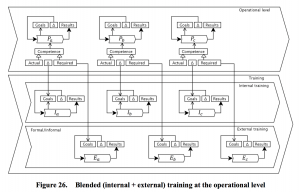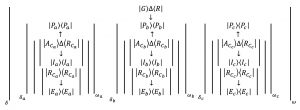This page is a sub-page of our page on TELL ME.
///////
Related KMR-pages:
• …
///////
Other related sources of information:
• TELLME-D1.3-Annex(v2).docx
Business Algebra: A Mathematical Framework for Business Process Modeling
///////
Figure 26 depicts three overall processes, an operational level production process for a large company (at the top), and two supporting training processes, internal training and external training. These refer respectively to the training processes that go on inside of respectively outside of the company.
The overall production process is shown broken up into three sub processes called \, P_a, P_b, P_c \, . The overall training processes are modeled as broken up accordingly, i.e., into the sub processes \, I_a, I_b, I_c \, for the internal training process respectively \, E_a, E_b, E_c \, for the external training process.
Moreover, let us define the parameters
\, A_C \, \stackrel {\mathrm{def}}{=} \, A_{ctual-Competence} \, and \, R_C \, \stackrel {\mathrm{def}}{=} \, R_{equired-Competence} .
Introducing the fork-and-join logics \, ({\delta}_a, {\omega}_a) \, ({\delta}_b, {\omega}_b) \, and \, ({\delta}_c, {\omega}_c) \, of the different parts and the overall fork-and-join logics \, (\delta, \omega) , we can represent the blended training strategy for the company by the following knowlecule:
This knowlecule is a three-step serialization. The knowlecule appearing at the top of each step is supported by the knowlecule appearing underneath the upward arrow for that step. The latter knowlecule consists of a two-channel parallelization, representing respectively the corresponding steps of the internal and the external training process.
As modelled graphically in Figure 26, the structural difference between the internal and external drivers of the training processes involved is reflected in the fact that while the internal training processes are controlled by gaps (“deltas”) between the corresponding actual and required competences, in contrast, the external training process is controlled by the required competences alone. This reflects the fact that a company normally has more reliable knowledge about the actual competence of its own workers, and the internal training processes can therefore target the closing of these gaps.
In contrast, the external training processes cannot make any similar assumptions, and therefore external learners should be assessed on their performance with respect to the required competences alone. This means that the external training processes will tend to be more uniformly targeted, while the internal training processes will tend to be more individualized. This is natural also from the perspective of phronesis, since the internal training processes normally can rely on an implicit repository of tacit knowledge about the workplace and the company.
This in fact the type of blending that is meant by the expression “blended training strategy”. In the future, company process training will be augmented in various ways. In many ways, for example, operating a numerically controlled machine has similarities with playing a computer game. These various forms of augmentation can be modelled by expressions such as \, \vert \, A_C \, \rangle \ast \langle \, R_C \, \vert \, where the operation \, \ast \, reflects the nature of the augmentation.
///////

